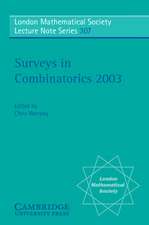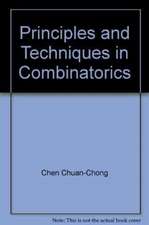Introduction to Combinatorics: Discrete Mathematics and Its Applications
Autor Walter D. Wallis, John C. Georgeen Limba Engleză Hardback – 12 ian 2017
Broadly speaking, combinatorics is the branch of mathematics dealing
with different ways of selecting objects from a set or arranging objects. It
tries to answer two major kinds of questions, namely, counting questions: how many ways can a selection or arrangement be chosen with a particular set of properties; and structural
questions: does there exist a selection or arrangement of objects with a
particular set of properties?
The authors have presented a text for students at all levels of preparation.
For some, this will be the first course where the students see several real proofs.
Others will have a good background in linear algebra, will have completed the calculus
stream, and will have started abstract algebra.
The text starts by briefly discussing several examples of typical combinatorial problems
to give the reader a better idea of what the subject covers. The next
chapters explore enumerative ideas and also probability. It then moves on to
enumerative functions and the relations between them, and generating functions and recurrences.,
Important families of functions, or numbers and then theorems are presented.
Brief introductions to computer algebra and group theory come next. Structures of particular
interest in combinatorics: posets, graphs, codes, Latin squares, and experimental designs follow. The
authors conclude with further discussion of the interaction between linear algebra
and combinatorics.
Features
- Two new chapters on probability and posets.
- Numerous new illustrations, exercises, and problems.
- More examples on current technology use
- A thorough focus on accuracy
- Three appendices: sets, induction and proof techniques, vectors and matrices, and biographies with historical notes,
- Flexible use of MapleTM and MathematicaTM
| Toate formatele și edițiile | Preț | Express |
|---|---|---|
| Paperback (1) | 308.44 lei 43-57 zile | |
| CRC Press – 21 ian 2023 | 308.44 lei 43-57 zile | |
| Hardback (1) | 602.92 lei 43-57 zile | |
| CRC Press – 12 ian 2017 | 602.92 lei 43-57 zile |
Din seria Discrete Mathematics and Its Applications
- 8%
 Preț: 404.92 lei
Preț: 404.92 lei - 20%
 Preț: 583.98 lei
Preț: 583.98 lei - 8%
 Preț: 409.45 lei
Preț: 409.45 lei - 9%
 Preț: 577.84 lei
Preț: 577.84 lei - 8%
 Preț: 460.70 lei
Preț: 460.70 lei - 9%
 Preț: 1531.97 lei
Preț: 1531.97 lei - 18%
 Preț: 799.85 lei
Preț: 799.85 lei - 18%
 Preț: 1114.97 lei
Preț: 1114.97 lei - 15%
 Preț: 568.28 lei
Preț: 568.28 lei - 20%
 Preț: 819.25 lei
Preț: 819.25 lei - 25%
 Preț: 1307.49 lei
Preț: 1307.49 lei - 28%
 Preț: 881.67 lei
Preț: 881.67 lei - 18%
 Preț: 790.34 lei
Preț: 790.34 lei - 15%
 Preț: 503.98 lei
Preț: 503.98 lei - 15%
 Preț: 687.11 lei
Preț: 687.11 lei - 20%
 Preț: 476.18 lei
Preț: 476.18 lei - 15%
 Preț: 485.18 lei
Preț: 485.18 lei - 31%
 Preț: 682.19 lei
Preț: 682.19 lei - 18%
 Preț: 1149.51 lei
Preț: 1149.51 lei - 18%
 Preț: 733.02 lei
Preț: 733.02 lei - 26%
 Preț: 1183.37 lei
Preț: 1183.37 lei - 25%
 Preț: 1247.82 lei
Preț: 1247.82 lei - 22%
 Preț: 352.95 lei
Preț: 352.95 lei - 15%
 Preț: 688.23 lei
Preț: 688.23 lei - 18%
 Preț: 1343.56 lei
Preț: 1343.56 lei - 33%
 Preț: 435.86 lei
Preț: 435.86 lei - 15%
 Preț: 495.83 lei
Preț: 495.83 lei -
 Preț: 469.34 lei
Preț: 469.34 lei - 20%
 Preț: 1051.90 lei
Preț: 1051.90 lei - 35%
 Preț: 408.36 lei
Preț: 408.36 lei - 27%
 Preț: 557.90 lei
Preț: 557.90 lei - 20%
 Preț: 1658.39 lei
Preț: 1658.39 lei - 15%
 Preț: 686.00 lei
Preț: 686.00 lei - 20%
 Preț: 1404.99 lei
Preț: 1404.99 lei - 18%
 Preț: 1333.77 lei
Preț: 1333.77 lei - 25%
 Preț: 487.41 lei
Preț: 487.41 lei - 26%
 Preț: 1238.95 lei
Preț: 1238.95 lei - 15%
 Preț: 671.43 lei
Preț: 671.43 lei - 18%
 Preț: 787.17 lei
Preț: 787.17 lei - 20%
 Preț: 833.11 lei
Preț: 833.11 lei - 18%
 Preț: 848.27 lei
Preț: 848.27 lei - 31%
 Preț: 1040.26 lei
Preț: 1040.26 lei - 31%
 Preț: 1177.39 lei
Preț: 1177.39 lei
Preț: 602.92 lei
Preț vechi: 804.69 lei
-25% Nou
Puncte Express: 904
Preț estimativ în valută:
115.41€ • 125.40$ • 97.00£
115.41€ • 125.40$ • 97.00£
Carte tipărită la comandă
Livrare economică 21 aprilie-05 mai
Preluare comenzi: 021 569.72.76
Specificații
ISBN-13: 9781498777605
ISBN-10: 1498777600
Pagini: 444
Ilustrații: 214
Dimensiuni: 152 x 229 x 31 mm
Greutate: 0.77 kg
Ediția:Revised
Editura: CRC Press
Colecția CRC Press
Seria Discrete Mathematics and Its Applications
Locul publicării:Boca Raton, United States
ISBN-10: 1498777600
Pagini: 444
Ilustrații: 214
Dimensiuni: 152 x 229 x 31 mm
Greutate: 0.77 kg
Ediția:Revised
Editura: CRC Press
Colecția CRC Press
Seria Discrete Mathematics and Its Applications
Locul publicării:Boca Raton, United States
Cuprins
Introduction
Some Combinatorial Examples
Sets, Relations and Proof Techniques
Two Principles of Enumeration
Graphs
Systems of Distinct Representatives
Fundamentals of Enumeration
Permutations and Combinations
Applications of P(n, k) and (n k)
□Permutations and Combinations of Multisets
Applications and Subtle Errors
Algorithms
Probability
Introduction
Some Definitions and Easy Examples
Events and Probabilities
Three Interesting Examples
Probability Models
Bernoulli Trials
The Probabilities in Poker
The Wild Card Poker Paradox
The Pigeonhole Principle and Ramsey’s Theorem
The Pigeonhole Principle
Applications of the Pigeonhole Principle
Ramsey’s Theorem — the Graphical Case
Ramsey Multiplicity
Sum-Free Sets
Bounds on Ramsey Numbers
The General Form of Ramsey’s Theorem
The Principle of Inclusion and Exclusion
Unions of Events
The Principle
Combinations with Limited Repetitions
Derangements
Generating Functions and Recurrence Relations
Generating Functions
Recurrence Relations
From Generating Function to Recurrence
Exponential Generating Functions
Catalan, Bell and Stirling Numbers
Introduction
Catalan Numbers
Stirling Numbers of the Second Kind
Bell Numbers
Stirling Numbers of the First Kind
Computer Algebra and Other Electronic Systems
Symmetries and the P´olya-Redfield Method
Introduction
Basics of Groups
Permutations and Colorings
An Important Counting Theorem
P´olya and Redfield’s Theorem
Partially-Ordered Sets
Introduction
Examples and Definitions
Bounds and lattices
Isomorphism and Cartesian products
Extremal set theory: Sperner’s and Dilworth’s theorems
Introduction to Graph Theory
Degrees
Paths and Cycles in Graphs
Maps and Graph Coloring
Further Graph Theory
Euler Walks and Circuits
Application of Euler Circuits to Mazes
Hamilton Cycles
Trees
Spanning Trees
Coding Theory
Errors; Noise
The Venn Diagram Code
Binary Codes; Weight; Distance
Linear Codes
Hamming Codes
Codes and the Hat Problem
Variable-Length Codes and Data Compression
Latin Squares
Introduction
Orthogonality
Idempotent Latin Squares
Partial Latin Squares and Subsquares
Applications
Balanced Incomplete Block Designs
Design Parameters
Fisher’s Inequality
Symmetric Balanced Incomplete Block Designs
New Designs from Old
Difference Methods
Linear Algebra Methods in Combinatorics
Recurrences Revisited
State Graphs and the Transfer Matrix Method
Kasteleyn’s Permanent Method
Appendix 1: Sets; Proof Techniques7
Appendix 2: Matrices and Vectors
Appendix 3: Some Combinatorial People
Some Combinatorial Examples
Sets, Relations and Proof Techniques
Two Principles of Enumeration
Graphs
Systems of Distinct Representatives
Fundamentals of Enumeration
Permutations and Combinations
Applications of P(n, k) and (n k)
□Permutations and Combinations of Multisets
Applications and Subtle Errors
Algorithms
Probability
Introduction
Some Definitions and Easy Examples
Events and Probabilities
Three Interesting Examples
Probability Models
Bernoulli Trials
The Probabilities in Poker
The Wild Card Poker Paradox
The Pigeonhole Principle and Ramsey’s Theorem
The Pigeonhole Principle
Applications of the Pigeonhole Principle
Ramsey’s Theorem — the Graphical Case
Ramsey Multiplicity
Sum-Free Sets
Bounds on Ramsey Numbers
The General Form of Ramsey’s Theorem
The Principle of Inclusion and Exclusion
Unions of Events
The Principle
Combinations with Limited Repetitions
Derangements
Generating Functions and Recurrence Relations
Generating Functions
Recurrence Relations
From Generating Function to Recurrence
Exponential Generating Functions
Catalan, Bell and Stirling Numbers
Introduction
Catalan Numbers
Stirling Numbers of the Second Kind
Bell Numbers
Stirling Numbers of the First Kind
Computer Algebra and Other Electronic Systems
Symmetries and the P´olya-Redfield Method
Introduction
Basics of Groups
Permutations and Colorings
An Important Counting Theorem
P´olya and Redfield’s Theorem
Partially-Ordered Sets
Introduction
Examples and Definitions
Bounds and lattices
Isomorphism and Cartesian products
Extremal set theory: Sperner’s and Dilworth’s theorems
Introduction to Graph Theory
Degrees
Paths and Cycles in Graphs
Maps and Graph Coloring
Further Graph Theory
Euler Walks and Circuits
Application of Euler Circuits to Mazes
Hamilton Cycles
Trees
Spanning Trees
Coding Theory
Errors; Noise
The Venn Diagram Code
Binary Codes; Weight; Distance
Linear Codes
Hamming Codes
Codes and the Hat Problem
Variable-Length Codes and Data Compression
Latin Squares
Introduction
Orthogonality
Idempotent Latin Squares
Partial Latin Squares and Subsquares
Applications
Balanced Incomplete Block Designs
Design Parameters
Fisher’s Inequality
Symmetric Balanced Incomplete Block Designs
New Designs from Old
Difference Methods
Linear Algebra Methods in Combinatorics
Recurrences Revisited
State Graphs and the Transfer Matrix Method
Kasteleyn’s Permanent Method
Appendix 1: Sets; Proof Techniques7
Appendix 2: Matrices and Vectors
Appendix 3: Some Combinatorial People
Notă biografică
W.D. Wallis is Professor Emeritus of Southern Illiniois University. John C George is Asscoiate Professor at Gordon State College.
Recenzii
In Introduction to Combinatorics, Wallis (emer., Southern Illinois Univ.) and George (Gordon State College) present a well-thought-out compilation of topics covering elementary combinatorics. At the beginning, the authors present a thorough background on the fundamentals of combinatorics with topics such as permutations and combinations, the pigeonhole principle, and the principle of inclusion and exclusion. Later chapters are independent of one another and can be selected based on student and instructor interests. These topics include graph theory, coding theory, and balanced incomplete block designs. At the end of each chapter, there are exercises and problems. These vary in difficulty from straightforward practice to more involved proof problems. Solutions and/or hints are provided in the back of the book. In addition, three appendixes discuss proof techniques, matrices and vectors, and historical figures; these allow flexibility in covering the material in various ways that can be based on students’ backgrounds. Overall, this textbook is a highly readable work that will benefit and enlighten all those interested in learning about combinatorics. It will work in a traditional classroom setting and for independent study. Given the level of material, it is geared toward junior or senior level undergraduate students.
--S. L. Sullivan, Catawba College
--S. L. Sullivan, Catawba College
Descriere
The purpose of this undergraduate textbook is to offer all the material suitable for a beginning combinatorics course for students in STEM subjects particularly mathematics and computer science, although other subjects may benefit as well. This will be achieved through the use of plentiful (though brief) examples, and a variety of exercises and problems. In addition, we use in our examples more up-to-date ideas (such as digital music files rather than books on a shelf) and give some code to assist the student with the use of Mathematica, Maple, and other technological tools.










